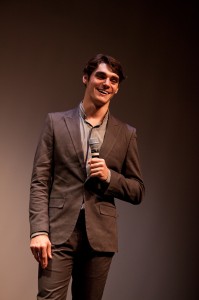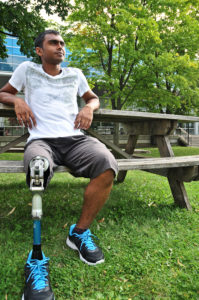According to Statistics Canada, about 15 per cent of the world’s population is affected by a disability, and over 3.8 million people in Canada live with a disability.
Yet, we rarely see characters with disabilities on TV.
Beyond that, we see even fewer actors with disabilities.
RJ Mitte, who plays Walter Jr. on the hit tv show Breaking Bad is an example of the small percentage of actors with a disability. Mitte, like Walter Jr., has cerebral palsy. He was diagnosed at the age of three.
In regards to characters with disabilities being played by actors without the disability, Mitte said, “If you look at it on an accurate level and if you want to portray real characters, they have disabilities. They’re out there. They’re not unicorns. They’re living normal lives and people need to see them for what they are.”
History
Roy Hanes, a Carleton associate professor in the school of social work, said despite the fairly large population of people with disabilities, this isn’t reflected in the media.
And the few characters who are on TV are often portrayed inaccurately.
“I think what the media does is build on a long history of stereotypes to include in film,” he said.
Hanes said people with disabilities are usually stereotyped into multiple categories, but the most common is the role of the victim.
“There’s this belief in our society that nothing can be worse than being disabled, which is a terrible value system that we have,” he said.
He said there’s a notion that people with disabilities constantly have to overcome their disability, and this simply isn’t true.
“If we were to have inaccuracies about 3.5 million other people, do you think that would be acceptable?” he asked.
Hanes said a large part of the problem is that able-bodied actors are hired to play characters with disabilities and more often than not, they don’t do an accurate job.
For example, in the hit TV show Glee, the character Artie Abrams uses a wheelchair due to a spinal injury, but the actor who plays Artie doesn’t have a disability at all. In fact, he is known to be a skilled dancer—something his character daydreams about being able to do.
Hanes said the character feels the need to overcome his disability as the only way he can feel fulfilled is in his dreams.
“The question I often have is why would you need to have a character with a disability, and if you did, why not have an actor with an impairment,” he said. “There are a number of performing artists who use wheelchairs, but they don’t often get asked to take on these roles.”
Not so long ago, Hanes said we were doing the same thing with racial minorities. In the past, people of colour weren’t portrayed in film by people of that actual demographic—something that wouldn’t be acceptable today.
Caucasian actors would wear makeup to play black characters, or they would tape their eyes back so they could play Asian characters in films, he said.
Yet on TV today, able-bodied actors play disabled characters all the time.

Mitte said he doesn’t mind when able-bodied actors play characters with disabilities. “But I do mind when they don’t get it right,” he said.
Hanes added, “If you understand the position of people with disabilities from a minorities perspective, we do a lot of things that we might not do with other minority populations.”
Hanes developed and now teaches the first critical disability theories class at Carleton—a class he said addresses the inaccurate portrayals of people with disabilities.
This first-year class is part of a new program minor that Carleton offers.
Using comedy to reframe attitudes
Alan Shain said he frames disabilities in terms of relationships—his relationship to his environment and his culture.
Like Mitte, Shain is an actor with cerebral palsy. He is also a comedian and playwright.
The Carleton alum said his work focuses on
“using comedy and theatre to reframe how we understand disabilities.”
One of his plays “Still Waiting for that Special Bus” is about a disabled man who has a hot date.
He has everything planned out, but the only thing preventing him from getting there is the bus to get to his date, which never comes and he’s eventually forced to take a cab.
“This play starts with the premise that a disabled guy is lacking love and romance in his life but typically, this would be framed around his disability and how no one will accept him or understand him or go out with him,” Shain explained.
“But in my play, he has a date, he has someone that wants to see him, but because of inaccessible transit, he can’t get to the actual date.”
“The play frames his disability not in terms of not being able to walk, but more in terms of the inaccessible environment and in terms of attitudes, because people don’t expect disabled people to date or to have partners,” he said.
Shain said he aims to show a different kind of representation of disabilities than what is traditionally seen in the media.
He was also one of the featured performers at University of Ottawa’s Disability Arts Nights, where he performed his stand-up comedy set.
He said the media tends to focus on the cause of the disability or on how hard it is to be disabled, and events like these allow “people to see disabled people represented in a completely different way.”
“I think it’s really helpful towards changing attitudes,” he said.
Overcoming adversity vs. personal achievement

Selvan Mohan, a Carleton student who’s using a crowdfunding site to raise money for a new prosthetic leg, said he wants to have equal opportunity.
“I want my achievements to be compared to any other human being rather than because of my disability,” he said.
He said attitudes are shifting for the better, as awareness surrounding disabilities is growing.
“It’s changing based on seeing that people with disabilities are equally competitive. We are capable of doing the same things,” he said.
Mohan regularly volunteers with the Paul Menton Centre, tutoring other students with disabilities.
He is also part of the Research, Education, Accessibility and Design initiative, which is a program focused on making Carleton a more accessible environment for students with disabilities.
Times are changing?
“The problem is disabilities haven’t been portrayed accurately in the media—it’s usually the angry cripple or the victim,” Mitte said.
This is a mindset that needs to change and society has to see people with disabilities as no different, he said.
“It’s growing. We have amazing shows like Breaking Bad and Switched at Birth and other shows that are incorporating disability,” he said. “And not in a negative way, not as victims.”
Although Shain said he doesn’t see much of a difference in how the media portrays disabilities, he said “I think we have a few cases like RJ Mitte and his character on Breaking Bad where we see this character who happens to have a disability, but it’s not the focus of the show.”
He added there needs to be more disabled artists, performers, writers and journalists present in the media. Only then, will we be able to get a more accurate portrayal of disabilities.
It’s not about the disability
Shain said he sees disabilities as more than general relationships.
“I don’t deny that I have cerebral palsy, and I walk and talk differently,” he said. “But what’s important is how I relate to the world and how the world relates to me as a disabled person.”
Mitte emphasized the importance of accurately portraying people with disabilities in entertainment by having actors with disabilities fulfill those roles.
“They can grow and expand and that’s what people need to see is a real-life person with a disability. And that’s what I’ve been lucky enough to do for the most part.”






